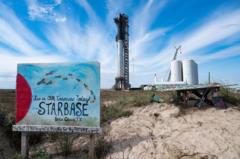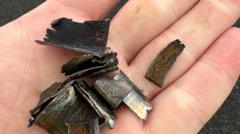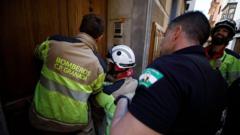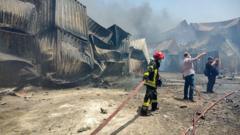The latest test flight of SpaceX's Starship ended in disaster as the upper stage exploded over the Caribbean. The incident prompted the Federal Aviation Administration to pause operations until a thorough investigation is completed.
US Halts SpaceX's Starship Test Flight Amid Explosion Investigation
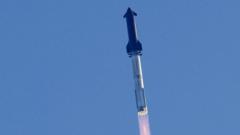
US Halts SpaceX's Starship Test Flight Amid Explosion Investigation
The FAA suspends SpaceX's Starship operations following debris fallout from a failed test in the Caribbean.
The much-anticipated test flight of SpaceX’s Starship, the largest and most potent rocket ever constructed, ended abruptly when the upper stage disintegrated mid-air following its launch from Texas on Thursday. The explosion occurred over the Caribbean, leading to flight diversions as a precaution against the falling debris.
The Federal Aviation Administration (FAA) has taken action by grounding the Starship while it collaborates with SpaceX and relevant authorities to assess any potential damage to property on the Turks and Caicos Islands. Although no injuries were reported, the FAA activated a "debris response area" to manage air traffic safely during the emergency.
SpaceX was instructed to conduct a "mishap" investigation, as stated by the FAA, to unravel the circumstances that led to the mishap, with the findings expected to influence whether Starship can resume operations. Several aircraft had to divert, some citing low fuel levels, when controlled outside the area where debris fell.
This test flight marked the seventh mission of Starship and, notably, involved an upgraded model that is two meters taller than its predecessors. SpaceX had confidently described this latest iteration as a "next-generation ship" with substantial enhancements, intending for it to execute a controlled splashdown in the Indian Ocean approximately an hour post-launch.
The launch proceeded smoothly at 17:38 EST (22:38 GMT), and the upper stage successfully separated from its Super Heavy booster just under four minutes into the flight. However, after that, mission control lost contact with the upper stage, casting a shadow on the early successes of the mission.
Purportedly, the Super Heavy booster did return to the launchpad as intended, drawing cheers from the teams at ground control. SpaceX later confirmed on its platforms that the upper stage had experienced "rapid unscheduled disassembly," a phrase used to describe the catastrophic failure.
Elon Musk, CEO of SpaceX, mentioned preliminary assessments pointed to an "oxygen/fuel leak in the cavity above the ship engine firewall" as the potential cause. Despite the incident, Musk expressed optimism, indicating that nothing so far suggests postponing the next launch, which could happen in the following month.
Starship, together with the Super Heavy booster, stands 123 meters (403 feet) tall and is designed to be fully reusable, fulfilling aspirations not only for lunar missions in NASA’s Artemis program but also for Mars exploration in the future.
Just hours before SpaceX's ill-fated test, Jeff Bezos’ Blue Origin successfully launched its New Glenn rocket system, marking a significant advance in space exploration ambitions for both billionaire founders.

